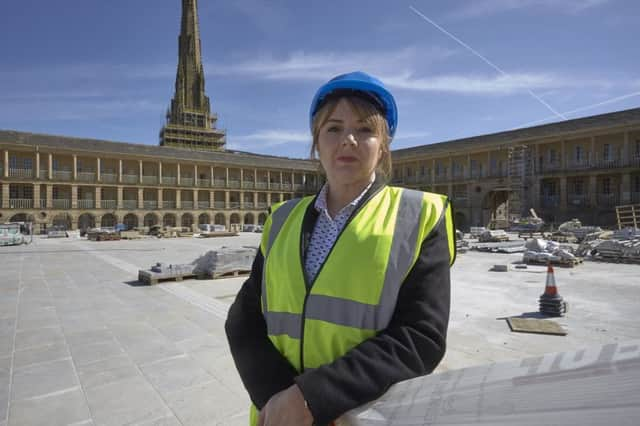Reopening date set for Halifax's cathedral to cloth


Halifax’s 18th century Piece Hall, the only remaining example of the great northern pre-industrial temples in which hand-loomed pieces of cloth were bought and sold, will finally reopen this summer after a restoration put at £19m.
After months of speculation, its developers announced today that at 10am on Yorkshire Day, August 1, the bell above the west gate would ring, just as it had on new year’s day, 1779, to declare the start of trading.
Advertisement
Hide AdAdvertisement
Hide AdIt is not the first rebirth for a vast, galleried quadrangle some call the northern Somerset House - though the one in Halifax is bigger.
When the textile trade mechanised in the 19th century and gravitated to the bright lights of Bradford, the Piece Hall became a wholesale fruit and veg market, and in the 1970s, rescued from dereliction, it reinvented itself as an artisan bazaar of bookstalls and craft shops.
It closed three years ago for the present transformation, which will see it pass from council to trust ownership and become one of the county’s principal event and performance venues, accommodating up to 7,500 people at a time.
More central than the Minster and billed now as one of Europe’s great public squares, it may grow into Halifax’s new town centre In any event, said council leader Tim Swift, it would become “the place to be”.
Advertisement
Hide AdAdvertisement
Hide Ad“There can’t be a more fitting date for the re-opening of the Piece Hall than Yorkshire Day, when we celebrate all that is great about our county,” he said.
“The transformation programme was about restoring and preserving it for future generations, but also about adapting an 18th century trading hall into a world class venue which will attract visitors from the UK and beyond.”
Nicola Chance-Thompson, chief executive of the Piece Hall Trust added: “That the Piece Hall is an architectural gem is without question. Together we will launch it as one of the most exceptional heritage, leisure and cultural destinations in the country.
“This is a major moment for the region. We are looking forward to welcoming visitors who already know and love the building, as well as meeting first time visitors.”
Advertisement
Hide AdAdvertisement
Hide AdWith three months to opening day, around 30 of the 53 former trading spaces, spread over three floors and now designated as retail, food and drink units, are still available.
As well as shops, bars and cafes, the Piece Hall will host concerts, an outdoor film season, art exhibitions and street theatre - a nod to the sort of thing that went on during one of its previous lives, when the Niagara tightrope walker Charles Blondin was shipped in to lurch across a cable stretched from one end of the quad to the other.
The hall had been built originally as the expense of local clothiers. In 1972, it came within a whisker of closing, when the development committee of the town council recommended against submitting a grant for its restoration.
Its successor, Calderdale Council, is on board this time, with the Heritage Lottery Fund and two foundations making up the funding.
Advertisement
Hide AdAdvertisement
Hide AdIn its original form, the Piece Hall housed basement stalls and two upper colonnades that led to more than 300 arched rooms where, every Saturday morning, unfinished cloth was put on sale to merchants.
The building and its 66,000 sq ft courtyard cost £12,000, and replaced an earlier cloth market.
Halifax’s cloth making history dates back to the 12th century, and by the mid-1400s its output was eight times that of Bradford.
But by the early 19th century, as industrialisation took hold and trading methods changed, it was forced to diversify into staging public spectacles such as hot air balloon races. In 1868, it was gifted to the council and turned into a wholesale food market.